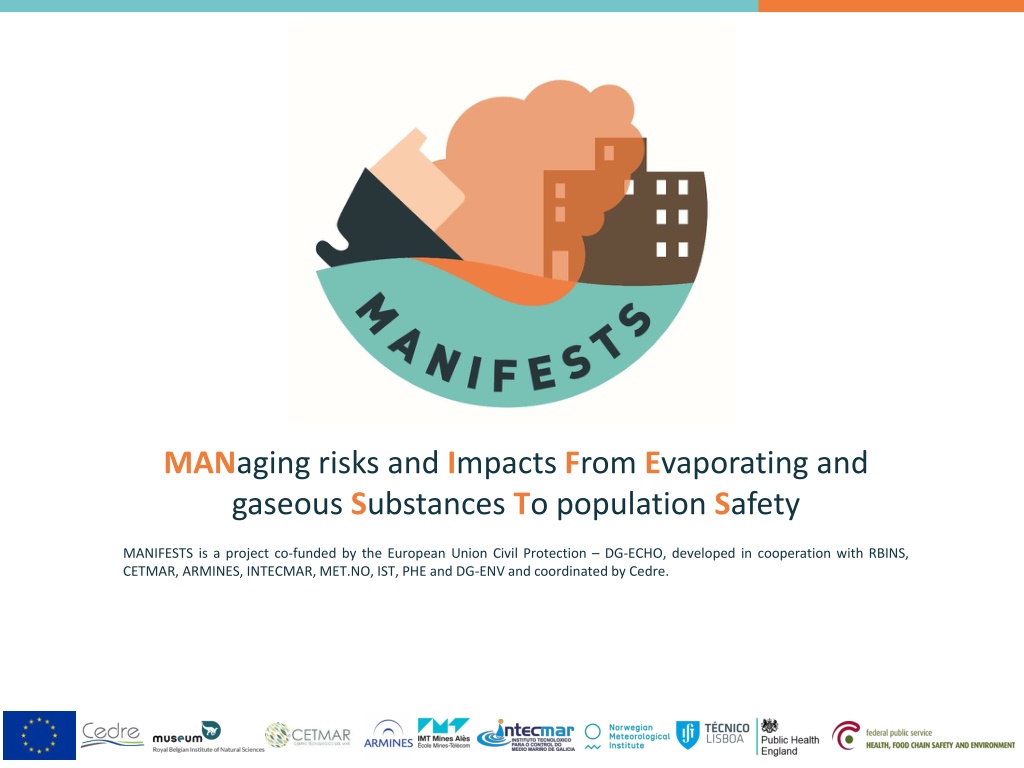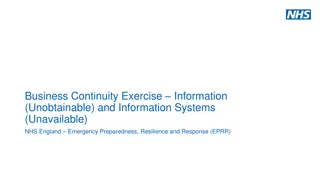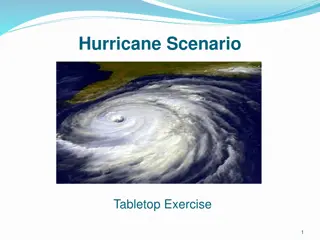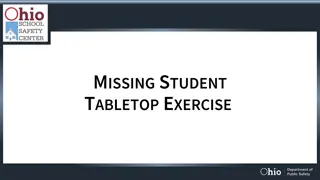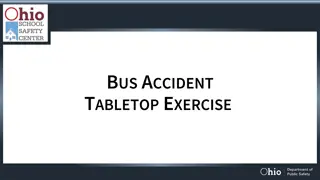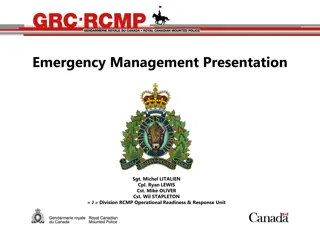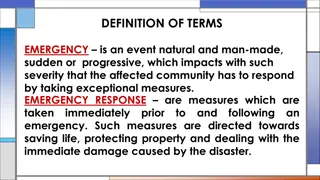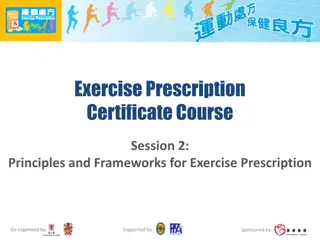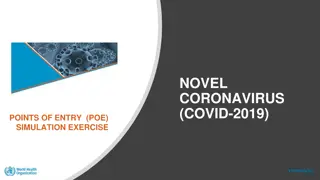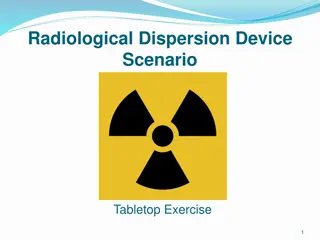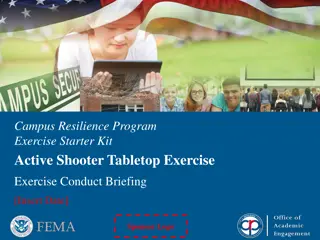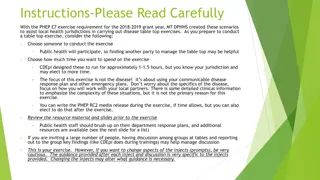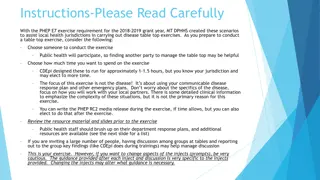Enhancing Emergency Response through Exercise Programs
Project MANIFESTS, co-funded by the EU Civil Protection, focuses on managing risks from gaseous substances to enhance population safety. Emphasizing the importance of exercising, it highlights the regulations and recommendations, such as establishing pre-positioned equipment, conducting exercises, and coordinating responses. Well-designed exercise programs help in assessing contingency plans, clarifying roles, improving coordination, identifying gaps, and boosting response performance. The cyclical approach suggests considering contingency plans, risk assessments, and lessons from past incidents for continuous improvement. Different levels of exercises include single-organization focused on operations and procedures and multi-agency focused on coordination.
Download Presentation

Please find below an Image/Link to download the presentation.
The content on the website is provided AS IS for your information and personal use only. It may not be sold, licensed, or shared on other websites without obtaining consent from the author. Download presentation by click this link. If you encounter any issues during the download, it is possible that the publisher has removed the file from their server.
E N D
Presentation Transcript
MANaging risks and Impacts From Evaporating and gaseous Substances To population Safety MANIFESTS is a project co-funded by the European Union Civil Protection DG-ECHO, developed in cooperation with RBINS, CETMAR, ARMINES, INTECMAR, MET.NO, IST, PHE and DG-ENV and coordinated by Cedre.
Co-funded by the European Union Civil Protection Types of exercises
Why exercising? Regulations such as the International Convention on Oil Pollution Preparedness, Response and Co-operation (OPRC), and its subsequent Protocol to the OPRC relating to hazardous and noxious substances (OPRC-HNS Protocol), adopted in 1990 and 2000, respectively, incorporate the following recommendations/obligations of contracting parties: Authorities in co-operation with contracting party shall establish: a) a minimum level of pre-positioned equipment for responding to pollution incidents; b) a programme of exercises for pollution incident response organizations and training of relevant personnel; c) detailed plans and communication capabilities for responding to a pollution incident; d) a mechanism or arrangement to co-ordinate the response to a pollution incident with the capabilities to mobilize necessary resources (art.4). Co-funded by the European Union Civil Protection
Why exercising? An exercise program with a good design and implementation allows the simulation of emergency response actions in a controlled environment, providing the opportunity to: assess and validate contingency plans, procedures, training, equipment or logistics; clarify roles and responsibilities of response and management teams; improve response coordination, integration and communication within and between organizations, stakeholders and media; identify gaps and opportunities to improve; develop individual and team confidence and competence; measure response performance increase and share situational awareness. Co-funded by the European Union Civil Protection
Why exercising? Cyclical approach To identify what to exercise, take into account: contingency plans requirements risk assessment and preparedness lessons identified from previous incidents and exercises Continuous improvement Two basic levels to organize an exercise: Single- organization (focused on operations and procedures) Multi-agency (focused on coordination) Local or regional (focused on events) National (focused on national risks) International (focused on transnational risks) Co-funded by the European Union Civil Protection
Key roles in an exercise Depending on the complexity of the scenarios to be tested, each exercise may require different roles/functions that may be assumed by one or more participants. Key roles are shown below. Participants Exercise management team Planners Controllers Players Sponsor/ organizer Facilitators Director Observers Role players Umpires Co-funded by the European Union Civil Protection
Key roles in an exercise. Functions Participants: Exercise management team: launch the proposal for the exercise and is responsible for the institutional relationships. Sponsor/organizer(s) Players personnel with active roles in the response. manage the exercise, including the planning, play and post exercise activities. Director plan the exercise in detail and reporting to the director. Planner(s) Observers control exercise blocks functioning, with minimal intervention. Controllers asses globally or partially and identify posible gaps or improvements. the exercise train, discussion or verify understanding of players. encourage participation, activate Facilitator(s) Role players design and conduct the exercise. evaluate conduction of activities according to pre-settedcriteria. Umpire(s) Co-funded by the European Union Civil Protection
Different classifications of exercises Classification proposed by FEMA (2018), IPIECA (2016): Classification proposed by GOV.UK (2022): Discussion-based: Seminars Workshops Table Top Discussion + Notification ex. (modif. from IPIECA, 1996) + Control post ex. (modif. from MCA UK, 1998) Test organisation Serious games Operations-based: Drills (real deployment of means) Live Functional exercises (simulated deployment) (test deployment of means) Full-scale exercises (real deployment) Co-funded by the European Union Civil Protection
Different classifications of exercises Classification proposed by FEMA (2018); IPIECA (2016) Discussion-based Used to introduce and/or develop new plans, policies and procedures and to test specific response elements (e.g. coordination among teams). The discussion is led by facilitators, who keep participants on track and ensure that exercise objectives are met. Operations-based Used to validate existing plans, policies and procedures, clarify roles and responsibilities, and identify gaps. Deployment of resources and personnel in reaction to an incident scenario. Co-funded by the European Union Civil Protection
Activities for the preparation of exercises Seminars Workshops Concept: Structured activities, with participation from relevant stakeholders to obtain consensus and produce effective plans, procedures, and agreements. Conducted based on clear objectives/goals. Concept: Lecture-based events with a simple program to present an overview into equipment, strategies, plans, policies, or procedures. They can be valuable when an entity is making changes or developing new plans or procedures. Develop a written product in coordinated activities Obtain consensus Collect or share information Find solutions to specific problems Objectives: Orient participants to new or existing equipment, plans, policies or procedures. Assess interagency capabilities or inter-jurisdictional operations. Construct a common framework. Objectives: Location/ resources: Meeting room, presentation facilities. Location/ resources: Meeting room, presentation facilities. Duration: Variable, minimal time constraints. Break-out sessions to explore parts of an issue with similar groups Duration: Variable, minimal time constraints. Examples: Link to Exercises Database Adapted from: Oil spill exercises, Good practice guidelines for the development of an effective exercise programme (IPIECA, 2016) and Course IS-120.C: An Introduction to Exercises (FEMA, 2018). Co-funded by the European Union Civil Protection
Exercises Table Top exercises (TTX) Concept: Roundtable type of session administered by a facilitator where members of a response team meet to discuss their roles, take decisions, test the use of existing plans and procedures and share observations regarding a simulated emergency scenario. Without outdoors mobilization Communication equipment or modeling tools can be used to be more realistic. Low stress, problem-solving environment. Should be announced to ensure availability. of personnel or equipment. Enhance general awareness, understandingof roles and responsibility Validate plans, policies and procedures Identify strengths, and areas for improvements Rehearse concepts and interactions between parties. Objectives: Location/ resources: Meeting room or rooms connected by communication means. Requires a simulation in form of a scenario and prewrittenexercise injects. Duration: Typically last 2 to 8 hours. Examples: Link to Exercises Database Co-funded by the European Union Civil Protection
Adapted from: Oil spill exercises, Good practice guidelines for the development of an effective exercise programme (IPIECA, 2016), IPIECA. A guide to oil spill exercise planning (1996) and MCA UK (Marine Coastguard Agency) The Exercise Planners Guide (1998). Exercises Notification exercises Control Post exercises Concept: Exercises to tests the procedures and equipment to alert the response teams. May be held at any time, announced or unannounced, conducted in conjunction with operational exercises or alone. Concept: Exercises to tests the procedures and equipment, working from the command locations to be used in real events. Test information flow, communications arrangements and equipment. Check availability of personnel Objectives: Test communications systems and ability. Check availability of personnel Objectives: Location/ resources: Communication systems that would be operational in real events. Location/ resources: Telephone and other means of communication with all the personnel in the same room or different locations Duration: Similar to table top exercises. Duration: Typically 1 to 2 hours. Examples: Link to Exercises Database Partners logo Co-funded by the European Union Civil Protection
Exercises Serious games Concept: Simulation of operations that often involve two or more teams, usually in a competitive environment, using rules, data, and procedures designed to depict an actual or hypothetical situation. Includes models and simulations on increasing complexity as the game progresses. Explore decision-making processes and consequences. Identify critical decision-making points Analyze existing plans and potential strategies Objectives: Location/ resources: Meeting room or rooms (one for each team of players) with internet connection, computers and appropriate software. Duration: Minimal time constraints. Examples: Link to Exercises Database Co-funded by the European Union Civil Protection
Exercises Equipment deployment exercises (Drills) Concept: Deployment of response equipment at particular locations in response to an scenario. Immediate feedback. Realistic but isolated environment. Low stress environment. Evaluate a specific function, equipment or capability. Provide training on new equipment or procedures. Evaluate new procedures or policies. Practice and maintain skills and teamwork. Assess availability and capabilities of equipment providers. Objectives: Location/ resources: In the workplace or workspace of the participants. Equipment and safety means (life lackets, boats, barges, trucks ), communications, models. Duration: Few hours, frequently repeated to acquire practice with the equipment. It might be run in conjunction with a table top exercise or incident management exercise. This can enhance the reality of the exercises. Examples: Link to Exercises Database Co-funded by the European Union Civil Protection
Exercises Incident management exercises (Functional Exercises) Concept: Simulation of the field response and deployment, involving the headquarters and/or coordination centers that would normally intervene in an emergency. Active interaction of participants in a simulated emergency (scenario). The scenario will be shaped by the interaction of the roles. Exercise plans, policies, procedures, and staff members involved in management, direction, command, and control functions. Validate and evaluate capabilities, multiple functions and/or sub- functions. Common situational awareness. Objectives: Location/ resources: Similar to Table-top exercises. Duration: Real-time, typically a full session, followed by debriefing sessions on the next day. Examples: Link to Exercises Database Co-funded by the European Union Civil Protection
Exercises Full-Scale Exercises Concept: Multi-agency, multi-jurisdictional activities designed to test coordinated responses and rapid problem solving skills. Often include many international players operating under the host nation command system. Mobilization of units, personnel, and equipment. Conducted in a realistic, real-time environment to mirror a real incident. High stress environment, rapid problem solving, critical thinking. Demonstrate roles and responsibilities as addressed in plans and procedures. Coordinate between multiple agencies, organizations and jurisdictions. Objectives: Location/ resources: all deployment, communication and safety means available from the agencies in charge of each task. Duration: Real-time, typically a full session, followed by debriefing sessions on the next day. Examples: Link to Exercises Database Co-funded by the European Union Civil Protection
References: Preparing Scotland (2022) Link GOV.UK. Emergency planning and preparedness: exercises and training (2022) Link DG ECHO. Technical Guide for UCPM Full-scale exercises (2021) Link FEMA (Federal Emergency Management Agengy). Course IS-120.C: An Introduction to Exercises (2018) Link IPIECA. Oil spill exercises, Good practice guidelines for the development of an effective exercise programme (2016) Link Arcopol Plus. Activity 3, Task 3.1.3: Guides for training forecasting exercises (2014). Link MCA UK (Marine Coastguard Agency) The Exercise Planners Guide (1998) Link IPIECA. A guide to oil spill exercise planning (1996) Link Partners logo Co-funded by the European Union Civil Protection
